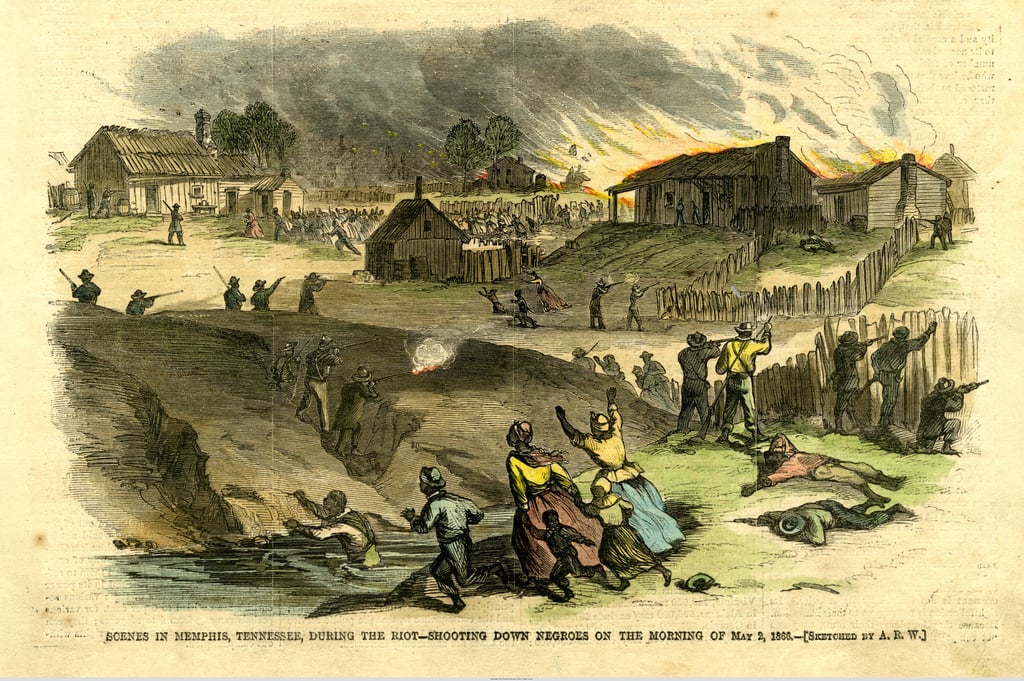 One hundred and fifty years ago, two massacres in 1866 – one in Memphis and one in New Orleans – galvanized national opposition to the Reconstruction policies that President Andrew Johnson enacted. These policies offered almost no protection to newly freed slaves in the aftermath of the Civil War.
One hundred and fifty years ago, two massacres in 1866 – one in Memphis and one in New Orleans – galvanized national opposition to the Reconstruction policies that President Andrew Johnson enacted. These policies offered almost no protection to newly freed slaves in the aftermath of the Civil War.
How can confronting challenging historical moments like these become a step toward truth and reconciliation around issues of race that we face today? First, we need to understand the history behind them.
In Memphis, an initial altercation between a predominantly Irish police force and members of the African American community sparked three days of violence. As unfounded rumors of an African American riot spread throughout the city, several citizens joined police to target African Americans. The massacre resulted in 49 deaths. All but three were African American.
Two months later, Radical Republicans reconvened the Louisiana Constitutional Convention in New Orleans to address the enactment of Black Codes and the state legislature’s unwillingness to extend the right to vote to African American males. To show their support of the Republicans, an estimated 200 African American veterans of the Union Army marched toward the Convention. As they approached, a riot broke out after former confederate soldiers and Democrats attacked them, leaving approximately 150 casualties.
Once we understand the history, we can better appreciate the impact these massacres have upon American society today. The violence of these events alarmed both the public and many politicians, furthering their lack of support for Johnson’s plan for Reconstruction. Seeking a change in leadership and policy, voters overwhelmingly voiced support of the Radical Republican approach to Reconstruction in the 1866 election. They were the catalyst for enacting a plan now known as Radical Reconstruction. For a brief, but important period of time, this resulted in real progress towards interracial democracy. Ultimately, these two massacres led to greater support of both Radical Reconstruction and the ratification of the 14th Amendment, the latter of which became the cornerstone of the Civil Rights Movement nearly a hundred years later.
When we bridge these connections from the past to the present, we can start to understand how the complexities of our past exist in today’s society, particularly in the context of modern day racial tensions in the U.S. Here are some guiding questions that may prove helpful for any community that chooses to confront challenging aspects of its collective past:
- Why is it important that we, as a community, confront this history?
- How do we (as educators, community members, or students) prevent ourselves from being paralyzed by the horrific nature of challenging histories?
- How can we both acknowledge the pain and suffering, while also trying to find hope and healing?
- What might justice look like as we confront these challenging histories?
- How do we begin to understand (while not justifying) the human behavior of the different actors involved (perpetrator, victim, bystander, upstander)?
These same questions can help us find a way forward – in the classroom and beyond – as we struggle with present day tensions. It is also important to allow ourselves to connect to these histories in a variety of ways – intellectually, emotionally, and ethically. Our approach, which uses a five-stage journey to integrate these three facets, is a useful framework that students, teachers, and community members can use to help better understand the world around them.
In closing I leave you with the words of W.E.B. DuBois, who so eloquently wrote, “Nations reel and stagger on their way; they make hideous mistakes; they commit frightful wrongs; they do great and beautiful things. And shall we not best guide humanity by telling the truth about all this, so far as the truth is ascertainable?"
Want to learn more about why we should study Reconstruction? Watch this video!

